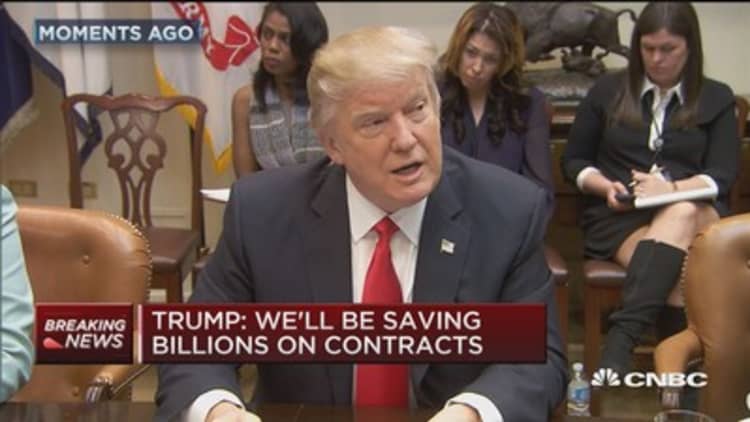
President Donald Trump's reference Monday to Lockheed Martin cutting the cost of the F-35 fighter jets by about $600 million will come from cost savings up and down the supply chain as the latest batch of planes is likely to be at record production levels for the program.
A deal for the 10th lot has yet to be finalized by the government but is expected to consist of about 90 planes valued below $9 billion and result in the unit price for the F-35A variant of the fighter falling below $100 million for the first time. The 90 fighter jets in the latest production lot are more than Lockheed has ever done before, so it's helping to drive down the overall unit costs.
Up until now, the so-called low-rate initial production contracts have been for smaller batches of F-35 Joint Strike Fighter aircraft. For instance, the LRIP-9 lot was for 57 F-35 aircraft and valued at $6.18 billion, resulting in the fighters running about $107 million each.
"We cut approximately $600 million off the F-35 fighter, and that only amounts to 90 planes out of close to 3,000 planes," Trump said speaking at the White House. He attributed that figure to Lockheed CEO Marillyn Hewson.
Trump, who has been a critic of the F-35 program's costs, began talks with Hewson on the F-35 even before getting sworn in as president of the U.S.
"We appreciate President Trump's comments this morning on the positive progress we've made on the F-35 program," Lockheed said in a statement Monday. "We share his commitment to delivering this critical capability for our men and women in uniform at the lowest possible cost to taxpayers."
With a bigger batch of F-35 orders, Lockheed will have more leverage to negotiate better terms with its partner companies and the jet's supplier base. Analysts have said the F-35's higher costs have been due in part to the government's practice of ordering the planes in smaller batches.
Each production lot is typically stretched out over three years or longer. Lockheed can chip away at aircraft costs during the F-35 production in the 10th batch due to the sheer number of jets as it benefits from economies of scale and gets more leverage to reduce costs up and down the supply chain.
Lockheed is currently producing F-35 stealth planes in LRIP 8 and 9. The 10th lot of the planes isn't expected to be delivered until 2018.
Meantime, Lockheed has already secured $1.3 billion on the 10th lot in what's known as "long-lead funding," or essentially a down payment from the government ahead of a final agreement.
To date, Lockheed has delivered more than 200 F-35 aircraft. There are nine original partner countries participating in the F-35 program and the production and maintenance also is global in scale. Most of the aircraft's assembly takes place at a plant in Fort Worth, Texas, but a handful of planes also were produced in Italy; later this year Japan will produce some jets.
Northrop Grumman is one of the partner companies in the F-35 program and provides the radar system while United Technologies' Pratt & Whitney division builds the jet's engine. U.K.-based BAE Systems also produces parts for the fifth-generation fighter.
Overall, the F-35 program has more than 1,250 suppliers in 45 states and Puerto Rico. The F-35 program — the most costly program in the U.S. military — could be valued at more than $1 trillion over the 55-year life cycle of the program.
Shares of Lockheed were down fractionally Monday along with the broader market. The stock is up nearly 20 percent in the past year.
The company didn't wish to comment beyond the press release it issued earlier Monday.



